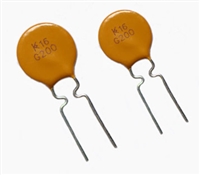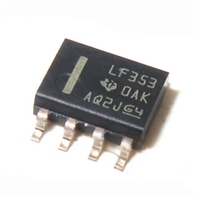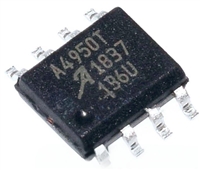A5976
Microstepping DMOS Driver with Translator
FUNCTIONAL DESCRIPTION
Internal PWM Current Control
Device Operation
The A5976 is a complete microstepping motor driver with built-
in translator for easy operation with minimal control lines. It is
designed to operate bipolar stepper motors in full-, half-,
Each full-bridge is controlled by a fixed off-time PWM current-
control circuit that limits the load current to an appropriate
level (ITRIP). Initially, a diagonal pair of source and sink DMOS
quarter-, and sixteenth-step modes. The current in each of the two outputs are enabled, and current flows through the motor wind-
output full-bridges, all N-channel DMOS, is regulated with fixed
off-time pulse-width modulated (PWM) control circuitry. The
full-bridge current at each step is set by the value of an external
current-sense resistor (RS), a reference voltage (VREF), and the
output voltage of its DAC (which in turn is controlled by the
output of the translator).
ing and the current-sense resistor, RS. When the voltage across
RS rises to the DAC output voltage, the current-sense comparator
resets the PWM latch, which turns off the source driver (in slow-
decay mode) or the sink and source drivers (in fast- or mixed-
decay mode).
The maximum level of current limiting is set by the selection of
RS and the voltage at the VREF input with a transconductance
function approximated by:
At power-up, or reset, the translator sets the DACs and phase
current polarity to the initial home state (see figures for home-
state conditions), and sets the current regulator for both phases to
mixed-decay mode. When a step command signal occurs on the
STEP input, the translator automatically sequences the DACs to
the next level (see Table 2 for the current level sequence and cur-
rent polarity). The microstep resolution is set by inputs MS1 and
MS2 as shown in Table 1. If the new DAC output level is lower
than the previous level, the decay mode for that full-bridge will
be set by the PFD input (fast, slow, or mixed decay). If the new
DAC level is higher or equal to the previous level, then the decay
mode for that full-bridge will be slow decay. This automatic
current-decay selection will improve microstepping performance
by reducing the distortion of the current waveform due to the
motor BEMF.
ITRIPmax = VREF / (8 × RS)
The DAC output reduces the VREF output to the current-sense
comparator in precise steps (see Table 2 for % ITRIPmax at each
step).
I
TRIP = (% ITRIPmax / 100) × ITRIPmax
It is critical to ensure that the maximum rating on the SENSE
terminal is not exceeded (0.5 V). For full-step mode, VREF can be
applied up to the maximum rating of VDD, because the peak sense
value is 0.707 × VREF / 8. In all other modes, VREF should not
exceed 4 V.
Fixed Off-Time
The DECAY input determines how the decay mode is selected
when stepping the motor. If the DECAY input is high, when step-
ping, if the new output levels of the DACs are higher than or equal
to their previous levels, then the decay mode for that full-bridge is
set to slow. If the DECAY input is high and the new output levels
of the DACs are lower than their previous output levels, then the
decay mode for that full-bridge is set by the state of the PFD input
(see PFD input description). This automatic current decay selection
improves microstepping performance by reducing the distortion of
the current waveform that results from the back-EMF of the motor.
If the DECAY input is low, then the decay mode is always set by
the state of the PFD input (see PFD input description). See Figure 6
on page 13 and Figure 7 on page 14 for decay mode detail.
The internal PWM current-control circuitry uses a one-shot to
control the time that the drivers remain off. The one-shot off-
time, tOFF, is determined by the selection of an external resis-
tor (RT) and capacitor (CT) connected between the RC timing
terminal and ground. The off-time, over a range of values of CT
= 470 pF to 1500 pF and RT = 12 kΩ to 100 kΩ is approximated
by:
tOFF = RT × CT
Allegro MicroSystems, LLC
7
115 Northeast Cutoff, Box 15036
Worcester, Massachusetts 01615-0036 (508) 853-5000
www.allegromicro.com






 NTC热敏电阻与PTC热敏电阻的应用原理及应用范围
NTC热敏电阻与PTC热敏电阻的应用原理及应用范围

 GTO与普通晶闸管相比为什么可以自关断?为什么普通晶闸管不能呢?从GTO原理、应用范围带你了解原因及推荐型号
GTO与普通晶闸管相比为什么可以自关断?为什么普通晶闸管不能呢?从GTO原理、应用范围带你了解原因及推荐型号

 LF353数据手册解读:特性、应用、封装、引脚说明、电气参数及替换型号推荐
LF353数据手册解读:特性、应用、封装、引脚说明、电气参数及替换型号推荐

 A4950资料手册解读:特性、应用、封装、引脚功能、电气参数及代换型号
A4950资料手册解读:特性、应用、封装、引脚功能、电气参数及代换型号
